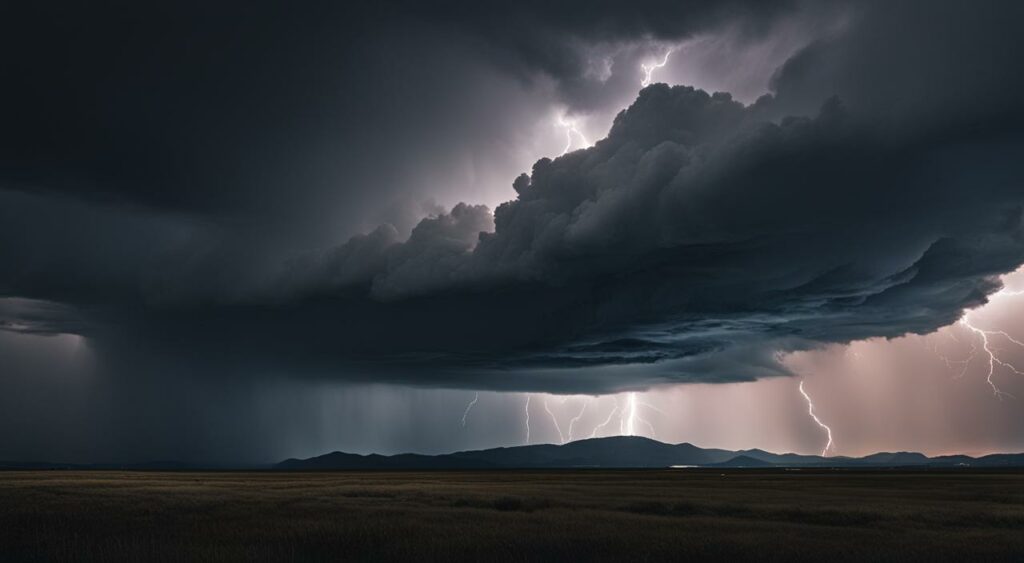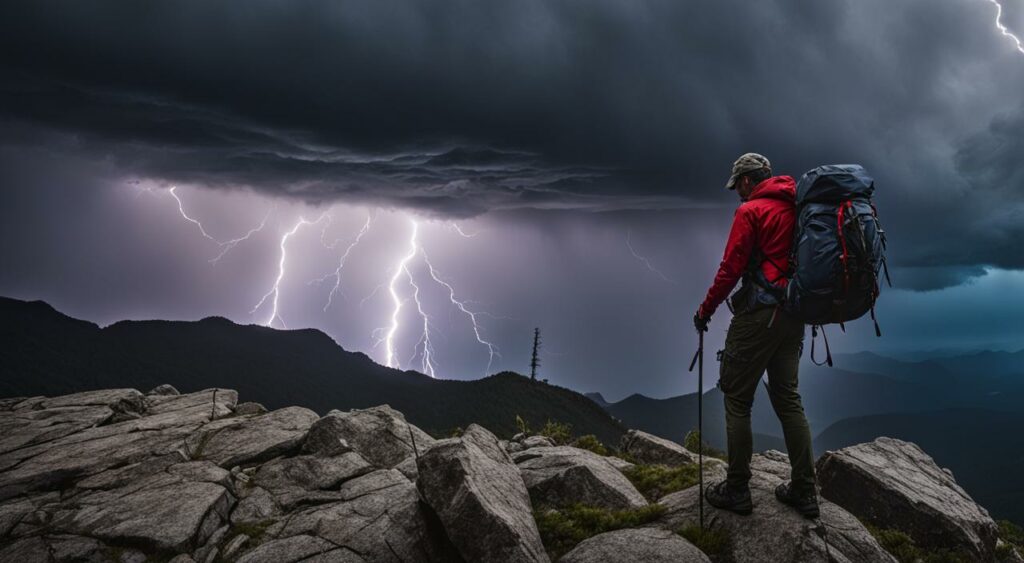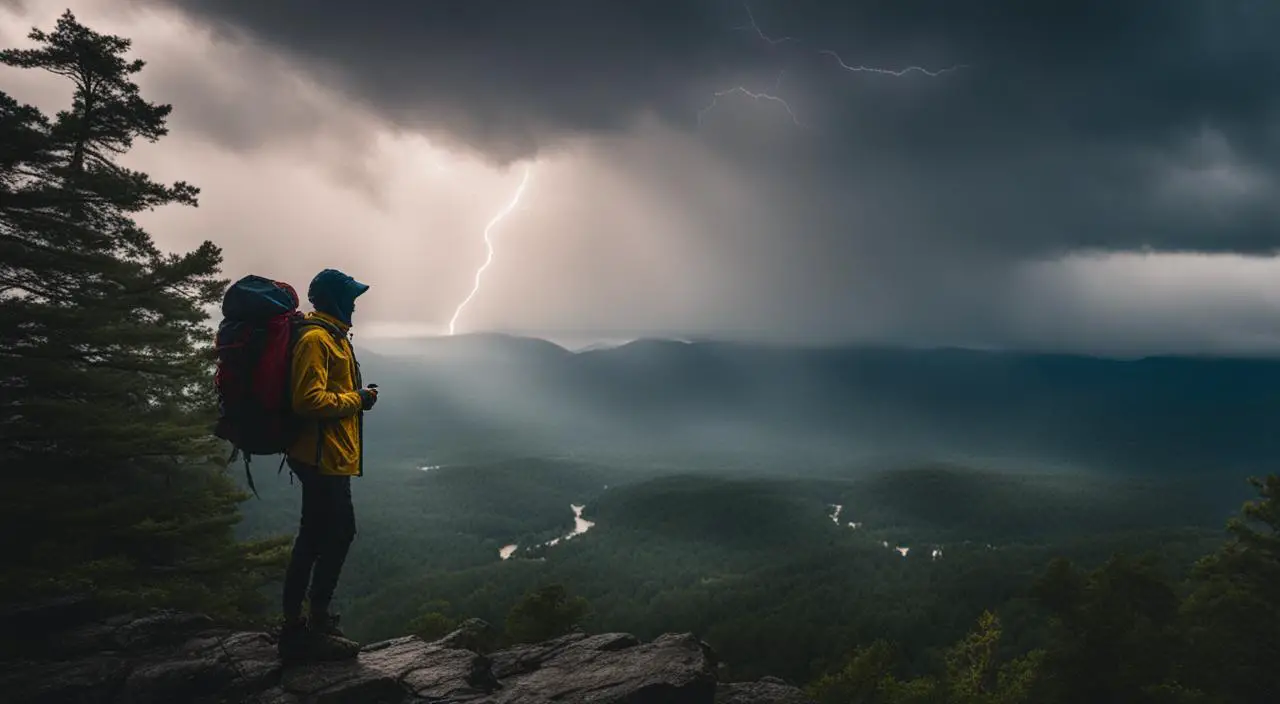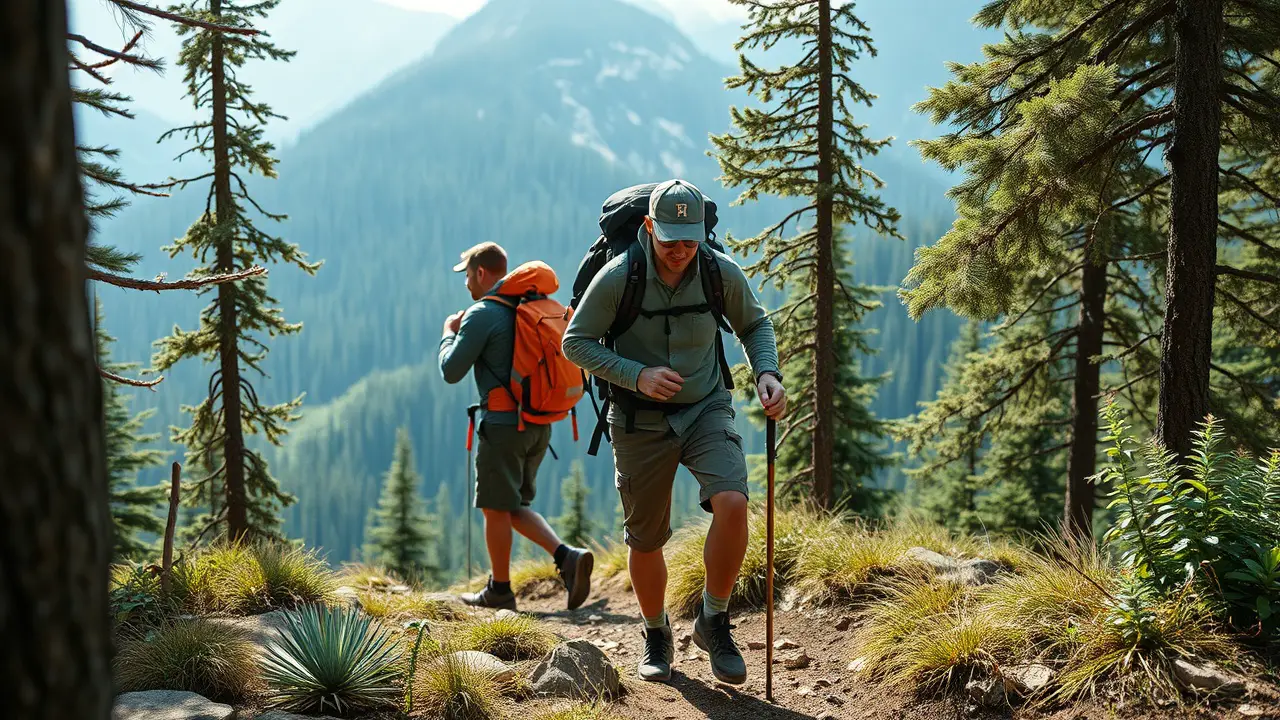Backpacking is a thrilling outdoor activity that allows you to immerse yourself in nature’s beauty. However, it can also expose you to unpredictable weather conditions, such as thunderstorms, which can be dangerous without proper preparation and knowledge.
Contents
Thunderstorms are a natural phenomenon that can be hard to predict, and when caught unaware, can pose a threat to your safety and well-being.
To ensure your safety while enjoying the great outdoors, it’s essential to be aware of the potential risks and have a plan in place.
In this article, we’ll provide you with valuable tips and strategies for backpacking during thunderstorms, including how to seek shelter, lightning safety precautions, and essential gear to pack.
Key Takeaways:
- Thunderstorms are a natural phenomenon that can be dangerous for backpackers.
- Proper preparation and knowledge are essential to ensure safety while backpacking in a thunderstorm.
- Strategies for seeking shelter, lightning safety precautions, and essential gear are crucial for backpacking in a thunderstorm.
Understanding Thunderstorms: Weather Basics and Conditions for Backpacking

Before embarking on a backpacking journey, it’s crucial to understand the basics of thunderstorms to ensure safety and preparedness during inclement weather.
Thunderstorms are atmospheric disturbances characterized by lightning and thunder, caused by the rapid movement of warm and cold air masses.
According to the National Oceanic and Atmospheric Administration (NOAA), thunderstorms are most common during the summer months in the United States, especially in the south and Midwest regions.
Thunderstorms can form quickly, and backpackers should be aware of the weather conditions that lead to their development.
Some of the weather basics that contribute to thunderstorms include:
- Warm, moist air mass that rises and cools quickly, leading to cloud formation
- A trigger such as a cold front, mountains or sea breezes that force the warm air to rise
Backpackers should also remain current on weather conditions for backpacking. It’s important to monitor forecasts for signs of thunderstorms and plan accordingly.
The National Weather Service provides regular weather updates and forecasts by region, including information on thunderstorms and other severe weather conditions.
“Thunderstorms are atmospheric disturbances characterized by lightning and thunder, caused by the rapid movement of warm and cold air masses.”
Lightning Safety Precautions: Essential Tips for Backpackers

Lightning storms can be highly dangerous for outdoor enthusiasts. Lightning can strike even when the storm is miles away, and the result can be catastrophic.
It’s essential to take lightning safety precautions to minimize the risk of harm.
According to REI expert advice, here are some essential lightning safety tips for backpackers:
- Check the weather forecast before setting out on your backpacking trip. If there is a possibility of thunderstorms, consider postponing your trip.
- Avoid setting up camp or taking shelter under tall trees or on elevated ground during a thunderstorm. Instead, find a low-lying area that’s not prone to flooding.
- If you’re in an open area during a thunderstorm, crouch down low on the ground, with your feet close together. This helps minimize the risk of electrical shock.
- Put away all metal objects, including hiking poles, and stay clear of any metal fences or other structures.
- If you’re camping in a tent during a thunderstorm, avoid touching the metal frame, and don’t hold any metal objects inside the tent.
- If you’re hiking in a group, spread out to avoid being in a group that is hit by lightning at the same time.
Remember that lightning safety is critical when backpacking in a thunderstorm. Make sure to stay informed about the weather forecast and follow essential safety precautions.
Essential Gear for Backpacking in a Thunderstorm: Waterproof Equipment and Emergency Preparedness
Backpacking during a thunderstorm can be dangerous, but with the right gear and emergency preparedness, backpackers can stay safe and dry.
This section will highlight the essential gear for backpacking in a thunderstorm, including waterproof equipment and emergency supplies.
Waterproof Gear
Investing in waterproof gear can make a significant difference in staying dry during a thunderstorm. The following table outlines some essential waterproof gear for backpacking in a thunderstorm:
| Item | Description |
|---|---|
| Rain Jacket | A waterproof and breathable jacket to keep you dry and prevent overheating. |
| Rain Pants | Waterproof pants that can be worn over regular hiking pants for added protection. |
| Waterproof Backpack Cover | A cover to protect your backpack and gear from getting wet. |
| Waterproof Hiking Boots | Waterproof hiking boots with good traction to prevent slipping on wet terrain. |
Additionally, it is recommended to pack extra waterproof gear, such as dry bags to keep electronic devices and other essentials dry.
Emergency Preparedness
Even with waterproof gear, unexpected situations can arise during a thunderstorm. It is essential to pack emergency supplies and be prepared for any scenario.
The following table outlines some important emergency supplies for backpacking in a thunderstorm:
| Item | Description |
|---|---|
| First-Aid Kit | A kit with essential medical supplies to treat injuries and illnesses. |
| Emergency Blanket | A lightweight and waterproof blanket to keep you warm and dry in case of an emergency. |
| Headlamp | A reliable and waterproof headlamp for navigating in low light conditions. |
| Portable Stove | A portable stove to heat up food and water if unable to start a fire. |
It is also recommended to pack extra food and water in case of unexpected delays or emergencies.
Strategies for Seeking Shelter: Cover and Ground Options During a Thunderstorm

Backpackers must be aware of the various shelter options available during a thunderstorm to avoid getting caught in the open or on elevated ground.
This section will outline different shelter strategies and highlight the importance of finding appropriate cover and avoiding open fields and tall trees.
Shelter Options for Camping and Backcountry
The most common shelter options for backpackers include camping tents and backcountry shelters. The type of shelter depends on the backpacker’s preference, the length of the trip, and the weather forecast.
It is essential to check the weather forecast regularly and choose the right shelter accordingly. Camping tents are versatile and come in various sizes, shapes, and materials.
While they provide adequate cover, they must be set up properly and secured for maximum protection. The tent must be pitched on flat ground, away from trees, and any water sources.
Backpackers should also check for any signs of damage and wear and tear before setting up camp. Backcountry shelters, also called lean-tos, are permanent structures built in designated campsites.
They can accommodate multiple backpackers and provide protection from the elements. However, they are limited in number, and backpackers must reserve them in advance.
Cover and Ground Options
If no shelter is available, backpackers must find other sources of cover and avoid elevated ground. Backpackers can use natural cover, such as caves, rock overhangs, or fallen trees, as temporary shelter.
However, backpackers must be cautious of any potential hazards such as flooding, falling debris, and wildlife. Ground cover options include low-lying areas, such as valleys or depressions, or dense vegetation.
These options provide low-risk cover from lightning strikes. However, backpackers must be cautious of flash-flooding and falling debris.
Avoid Open Fields and Tall Trees
Backpackers must avoid open fields, tall trees, and bodies of water during thunderstorms as they increase the risk of lightning strikes.
Instead, backpackers must find shelter in low-lying areas, dense vegetation, or natural cover. To summarize, backpackers must be aware of the various shelter options available during thunderstorms.
They must choose appropriate shelter, check the weather forecast regularly, and avoid open areas and tall trees.
Natural cover and low-lying areas can provide temporary protection but must be chosen wisely, and backpackers must always prioritize safety and preparedness.

Conclusion
Backpacking in a thunderstorm can be a thrilling experience, but it can quickly turn dangerous without proper preparation and precautions.
By understanding the basics of thunderstorms and staying informed about weather forecasts, backpackers can plan their trips accordingly and minimize the risks associated with thunderstorms.
Lightning safety should always be a top priority, and backpackers should take necessary precautions such as finding appropriate shelter and avoiding open areas and tall trees during thunderstorms.
Carrying essential gear, including waterproof equipment and emergency supplies, can also help ensure safety and preparedness in unexpected situations.
When seeking shelter during a thunderstorm, backpackers should prioritize finding appropriate cover and avoiding elevated ground.
Whether using camping tents or backcountry shelters, staying dry and protected is key to a safe and enjoyable outdoor adventure.
Remember, safety should always come first when backpacking in a thunderstorm.
By following the tips and strategies outlined in this guide, outdoor enthusiasts can enjoy the beauty of nature while minimizing the risks associated with thunderstorms.
Stay informed, stay prepared, and stay safe.

FAQ
-
What should I do if I’m backpacking in a thunderstorm?
If you find yourself backpacking in a thunderstorm, it is important to prioritize your safety. Seek appropriate shelter, avoid open areas and tall trees, and stay away from bodies of water. Additionally, be sure to stay informed about the weather forecast and plan your trips accordingly.
-
How do thunderstorms form?
Thunderstorms are formed when warm, moist air rises and collides with cooler air. This causes the warm air to condense, forming clouds. As the warm air continues to rise, it creates an upward motion that leads to the development of thunderstorm clouds. Thunderstorms are often associated with heavy rain, lightning, and strong winds.
-
What safety precautions should I take to avoid being struck by lightning?
To minimize the risk of being struck by lightning, it is important to find appropriate shelter during a thunderstorm. Avoid open areas, tall trees, and bodies of water. Look for a sturdy building or a fully enclosed vehicle if possible. If shelter is not available, find a low-lying area and crouch down, keeping your feet together. Avoid using electronic devices and stay away from metal objects.
-
What gear is essential for backpacking in a thunderstorm?
When backpacking in a thunderstorm, it is crucial to have waterproof gear. This includes a waterproof rain jacket, rain pants, and a waterproof backpack cover. It is also recommended to carry emergency supplies such as a first aid kit, a flashlight, extra food and water, and a whistle for signaling for help in case of an emergency.
-
What options do I have for seeking shelter during a thunderstorm while backpacking?
When seeking shelter during a thunderstorm while backpacking, it is important to find appropriate cover. This can include camping tents, backcountry shelters, or any sturdy structure that provides protection from the elements. Avoid setting up camp under tall trees or on elevated ground, as they can attract lightning strikes.











Leave a Reply